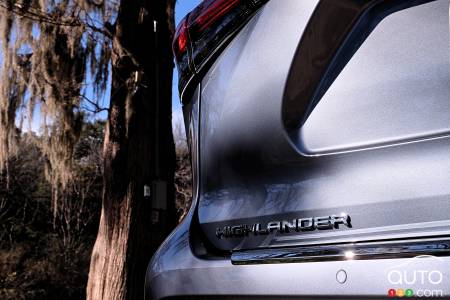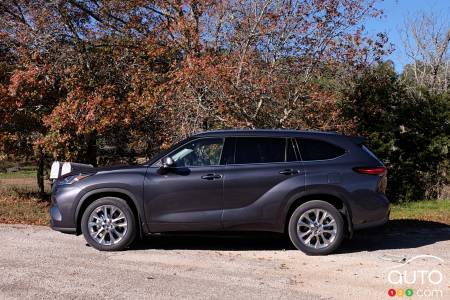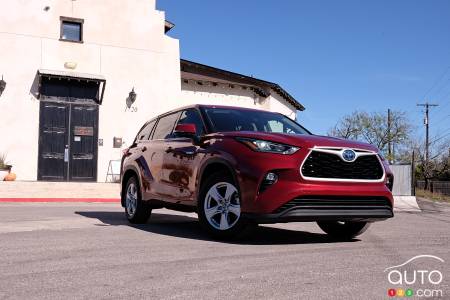San Antonio, TX – Toyota’s mid-size Highlander SUV helped create the intermediate crossover category it sits in back in 2001 when it was first introduced, and in fact for several years thereafter it was the brand’s top-selling utility model until the RAV4 put a stop to its rule. It has proven its staying power over the years. But with its last big overhaul dating from 2013, the Highlander was due for something more than a simple refresh.
And so it was that we headed for the home of the Alamo for a first drive of the all-new fourth-generation 2020 Toyota Highlander. Aside from the 3.5L V6 carried over from the outgoing model, it was a basically all-new vehicle we climbed into on a sunny morning for our day of driving in and around San Antonio, Texas.
The new Highlander generation, first unveiled back in April at the New York auto show, is the first built on the Toyota New Global Architecture (TNGA), a platform that allows for any number of updates, upgrades and improvements that impact on the efficiency, ride and in-cabin experience delivered by the SUV. It’s also the architecture underpinning a fair portion of the automaker’s current new-vehicle lineup, from the Corolla, Camry and Avalon sedans to the RAV4 juggernaut.
Auto123 launches Shopicar! All new makes and models and all current promotions.
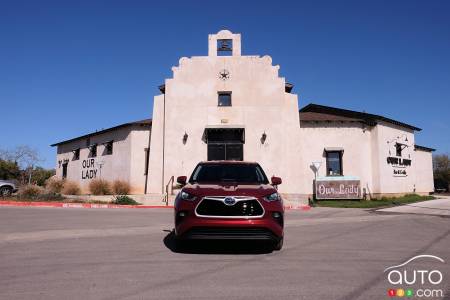
The powertrains
The new platform is designed to accommodate both an all-gas and a hybrid configuration, and that is what Toyota is offering for the Highlander in 2020. In the hybrid version (there’s no PHEV variant on the menu), the aforementioned 3.5L V6 of the “regular” Highlander is replaced by a 2.5L 4-cylinder unit working with a pair of electric motors. The V6 works with an 8-speed automatic transmission, while the hybrid powertrain incorporates a continuously variable transmission (CVT).
Here’s how the output of each version plays out: the V6 delivers 295 hp and 263 lb-ft of torque, and permits a maximal towing capacity of 5,000 lb – just as it did in the 2019 version. The hybrid version, meanwhile, makes a total of 243 hp, and towing capacity is 3,500 lb; this variant weighs 140 kg less than the previous Highland hybrid. While the output is notably less than in the combustion-engine-only configuration, you do get a 19% improvement in fuel economy, according to Toyota. More on that below.
Note that while Toyota is offering a front-wheel-drive configuration for the hybrid version for the American market, which will be less expensive than the AWD version, Toyota Canada has decided to bring only the latter to market here.
Note as well that buyers will have the choice of more than one all-wheel drive system to pick from. Depending on which Highlander trim they opt for, they’ll get either the Dynamic Torque Control or the new Dynamic Torque Vectoring system. Hybrid versions get electronic on-demand AWD, which includes a Trail Mode.
Fuel consumption
The choice for consumers will thus be a fairly clear one: more muscular performance from under the hood, or better fuel economy. And it is quite a bit better, judging both from the official numbers and from ours experienced on our first drive (obtained, admittedly, on very smooth, dry road surfaces in Texas in ideal warm-but-not-hot temperatures). Toyota’s combined number for the gas-only Highlander is 10.3L/100 km, while for the hybrid it drops to 6.7L/100 km.
That’s an impressive figure for a three-row people-mover, and in fact it translates into a total estimated range of 967 km. On this day we obviously did not have occasion to test that last figure, but we did put up fuel consumption numbers that matched, and sometimes beat, the official rating. On our single longest drive as the day came to a close, which covered highway, heavy traffic and city-street environments, we came up with 6.14L/100 km (in a FWD model). This will be music to many a Canadian motorist’s ears, we think.
The look
While the new Highlander is bigger than the RAV4, it’s actually a little softer in its overall shape than the compact SUV’s. The front end doesn’t stray miles from that of the current edition in shape, but the horizontal strips of the old grille are gone in favour of one that more closely approximates what you get on the nose of the RAV4. The headlights are suitably thinned out for a sleek, slightly aggressive look, and they are now LED.
The model gains 66 mm in overall length (60 mm in wheelbase), and 5 mm in width, but no increase in height, with the result that it looks more streamlined and road-focused in comparison with before.
The interior
Inside you get an updated version of the current interior environment, so there’s no big departure there. The touchscreen, at least the one in the high-end Platinum edition, is now 12.3-inch, the biggest in the segment according to Toyota. Those going for lower trims will have to settle for a (perfectly adequate) 8.0-inch screen. Android Auto and Apple CarPlay compatibility is included standard.
Comfort levels are really impressive, from the generous legroom and headroom to the firm but comfortable seats to the surfaces on the dashboard and doors; there’s nary a cheap plastic element in sight. The model, as before, can fit up to 8 occupants, though that’s reduced to 7 if you go for the available second-row captain’s chairs.
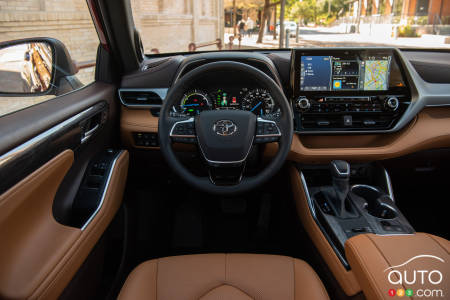
The third row is typical for a midsize SUV, which is to say strictly for children. Access isn’t too difficult but there’s precious little legroom back there. Fold those third-row seats down and the second row of seats as well and you get a cavernous cargo space in the back (2,037 litres as opposed to 454 with all the seats up), with even a nifty storage space under the floor adding additional room. Toyota says the hatch to access the cargo space opens two seconds faster than before – good news for us impatient types.
Safety
Offered standard in all versions from the get-go is the Toyota Safety Sense 2.0 suite of functions, which include: lane departure warning with steering assist, full-speed adaptive cruise control, forward collision warning with automatic emergency braking and pedestrian detection and automatic high beams, as well as lane keeping assist.
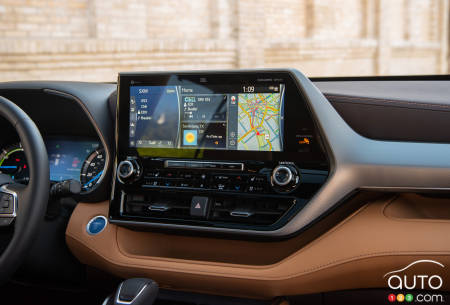
The versions
The 2020 Highlander is available in five different trims: L, LE, XLE, Limited and Platinum. All but the first of those can be had with the hybrid powertrain. The first and the last of them are also new to the Canadian market. Toyota expects however that the most popular choice for Canadian buyers will continue to be the XLE trim.
The base-model Highlander L starts at $39,990, and its gains over the 2019 LE (the former base trim) include, in addition to those mentioned above, heated front seats, 8-way power-adjustable driver’s seat, electronic parking brake and blind spot monitor. It features a front-wheel drive system and rides on 18-inch wheels.
Priced at $43,490 (slightly less than in 2019), the LE comes with AWD as well as a 4.2-inch colour data display for the driver, upgraded audio system and smart key with push-button start. The XLE edition starts at $45,990, just slightly above the 2019 version, and for that you get a 7-inch data display and LED fog lamps. Both of these come with standard all-wheel drive.
Move up to the Limited, and for $51,690 you get a premium audio system (a 1,200-watt, 11-speaker JBL unit), wireless charging, kick motion power hatch, larger 20-inch wheels and the Dynamic Torque Vectoring system. On top of the pile sits the new Platinum ($53,990), which gives you a head-up display, second-row captain’s chairs and heating for them, a digital display rearview mirror and a panoramic view monitor.
What about the hybrid versions, you ask? Toyota has put in place an aggressive pricing structure for these, requiring just a $2,000 premium in each trim level to gain access to that attractive 6.7L/100 km fuel consumption.
The drive
We did not, on this day, drive the 2020 Highlander up any mountains, or pull it off the road to attack rougher trails, or pull any weight. But we did get occasion to try out each of the versions of the crossover – and they were all made available to us – in the city, on smaller, winding roads and on the open highway. In the latter context the Highlander proves itself a supremely comfortable people mover, with sufficient power under the hood – even in the hybrid version – to make passing effortless and cruising at speed a quiet, smooth operation.
Otherwise, the increased length of the vehicle does affect its nimbleness in corners and its turning radius; the latter situation is the only time you’re reminded you’re at the wheel of a pretty large three-row utility vehicle. That said, the new Highlander never feels like a lumbering oaf. The steering is light but fairly precise, and the new TNGA architecture makes the whole chassis feel satisfyingly rigid.
Personally I’m certainly sold on the idea of a hybrid powertrain that can, with no effort or fuss, deliver such stingy fuel consumption from a big SUV, at an extra cost of only $2,000. It will be interesting to see what percentage of buyers in Canada goes that way as well. Those who do will have to be ready to pay the piper up front, though, especially if they’re drawn to the siren call of the more luxurious top-end trims. The 2020 Highlander Limited hybrid version lists at $53,690, while the Platinum hybrid goes for $55,990.
Consult our listing of pre-owned Toyota Highlander vehicles available in your region of Canada
We like
Solid, smooth and quiet ride
Sufficient power from under the hood
Very fuel-stingy hybrid option
Modern looks
We like less
Can be unwieldy in tight city traffic
Third row is still off-limits to adults
The competition
Honda Fit
Subaru Ascent
Ford Explorer
Hyundai Palisade
Kia Telluride
Volkswagen Atlas
